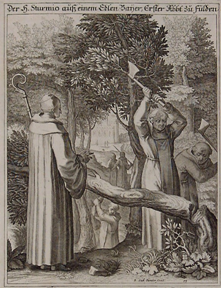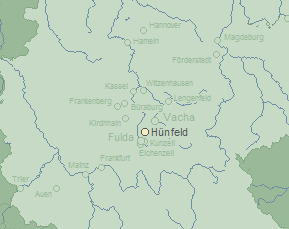
Witzel von H�nfeld
ca. 1390
( Witzel )

efore Witzel was adopted as a last name, it was used as a first name among the people of Hesse, Germany. � Among others who are known to have lived in Fulda aroung 1390 is Witzel von H�nfeld, described as a citizen of Fulda but, as the name describes, very likely born and raised in H�nfeld.

The history of H�nfeld is tied to the establishment of an abbey at Fulda. The abbey was one of several Christian missions established by the Frankish empire along its eastern border with the non-Christian Saxons and Slavs. Anglo-Saxon monks were recruited by bishop Bonifatius in an effort to settle the region. These Anglo-Saxon Christians were eager to bring the blessings of the new religion to their kindred Germans.
The monks provided the cultural center upon which communities were founded. Those who converted to Christianity found a place of protection. Wealthy families supported the Church to gain prestige and ranking positions among the new communities. Prevailing from ancient times, the interplay between the wise and the strong was basic to everyday life. As the border regions gained in stability, everyone found benefit in the prospering economy.

Bonifatius entrusted the task of estabishing the abbey of Fulda to a Benedictine monk amed Sturmius. As centuries passed, the monastery grew through a system of supporting religious centers and communities. Towns grew up around the Fuldan daughter-houses (-hausen) and cells (-zells) that speckled the countryside.
And villages like H�nfeld thrived in the fields of the abbey. The non-Frankish settlement of H�nfeld was granted to Fulda by the Holy Roman Emperor Charlemagne. Its favorable location along the Antsanvia - an old trade route which connected the middle Rhine with the Elbe River - allowed the rural settlement to gain in its prosperity.
The rich monastic environment brought together the Germanic and Slavic people of the region, as they worked the fields needed to support the religious community. Small tracts of land were granted in return for the payment of goods a harvest. In this way, abbeys like Fulda contributed even to the treasury in Rome.
It was not until 1137 that a castle - festeshaus - was built by the aristocratic Hertuvic de Hunnenfelt. He was rewarded for pledging his services to the Hohenstaufen Holy Roman Emperor Konrad III and protected Abbot Konrad I and the abbey at Fulda. Such strong protection allowed for a continued growth centered around Fulda.
Eventually, Fulda became an Imperial Abbey. The Abbot of Fulda reported directly to the Pope, instead of the regional Archbishop at Mainz. And as Fulda grew increasisngly prosperous, the positon was elevated to Prince Abbot, with all the benefits of nobility and answering only to the rule of the Emperor himself. Fulda, at its height, was the largest religious landholder in Germany.
Along with its impressive library, Fulda provided an abundance of skilled clerics. Clerks record the transactions of governance. Records of H�nfeld begin in the 1300s. Mention is made of the prominent Konrad Hunevelt, also documented as Konrad de Hunevelt and Cunrad von Hunefelt.
This is the time in Germany when the transition to last names begins to occur. It was not unusual for newcomers to a city to be refered to by their town of origin. And for some, this supplimentary description developed into their last name.
The name Witzel von H�nfeld is one of several names listed in a document dated May 21, 1390. � The document was drafted under the authority of Abbot Friedrich von Romrod and describes annual payments that are required to be made to the Propstei at Frauenberg. �
|
Witzel von H�nfeld, B�rger zu Fulda wird in einer Urkunde des Abts Friedrich v. Romrod (1383-1395) vom 21. Mai 1390[44] erw�hnt, letzterer verkauft an die Propstei Frauenberg j�hrliche Renten, welche die erw�hnten B�rger von ihren H�usern zu entrichten haben, darunter Witzel von H�nfeld. Witzel von H�nfeld, a citizen of Fulda, was mentioned in a document of the abbot Friedrich von Romrod (1383-1395) on May 21, 1390, explaning the annual rents at the Cloister Frauenberg which the mentioned citizens of its houses have to pay, under that Witzel of H�nfeld. |
The Cloister of Frauenberg is located on the northern limits of Fulda, in the direction of H�nfeld. Even today, the cloister serves as a place where quests may stay. �
1390 |
Witzel Herolt |
||
Witzel Hutte |
|||
Witzel von H�nfeld |
|||
Witzel Christoffel |
|||
1392 |
Witzel Harnasch |
||
1488 |
Witzel Bischoff |
09-06-2006
� |
Ditzel, Olaf. 'Georg Witzels Vorfahren in Vacha'. Fuldaer Geschichtsbl�tter. Nr. 74. 1998. pp. 77-104. |
� |
Freiherr v. H�nefeld, Andreas. 'Der Ursprung, Das Feld an der Haun'. Homepage der Familie der Freiherrn v. H�nefeld. Retrieved on September 7, 2006: http://www.huenefeld.org/Ursprung/ursprung.html. � |
� |
Witzel, Bernd. Willkommen bei meinem Hobby, der Ahnenforschung. http://bernd-witzel.de/seite_21.htm . Retrived on September 1, 2006. �. |

� Home � Site Menu � Contact �

